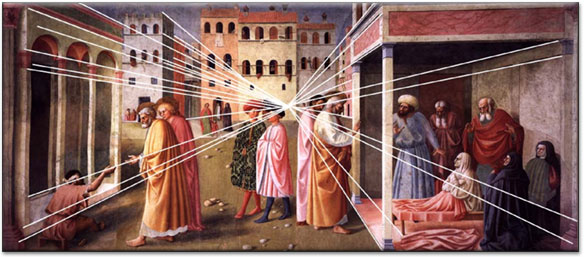Week Two - Math and Art
Week Two - Math and Art
While it’s easy to dismiss art and math as separate entities, math is integral to classical art and to advancing visual forms – it’s difficult to make the two any closer together. From Professor Vesna’s lecture, Robert Lang’s website on origami, and B. Sidney Smith’s writings on M.C. Escher, the relationship between math and art has been clearly pointed out as uniting forces. The most obvious example of this is in the idea of perspective. One point linear perspective was a hallmark of Renaissance art and to this day is paramount in the process of developing artistic skill. Linear perspective relies heavily on the scientific understanding of optics and its mathematical explanations. Without a strong understanding of the way our eyes and brains process images, a mimetic representation in art would not be possible. Art has, however, moved beyond the goal of mimesis and moves towards a broader understanding of the human experience.
M.C. Escher is an excellent example of this paradigm shift amongst artists. Escher shares a similar goal to mathematicians as his work demonstrates. Escher’s work expands upon mathematical advancements and discoveries and pushes the boundaries to see how much the factual and numerical can explore the emotional and visceral world of art. Works such as Regular Divisions with Birds build upon the mathematical idea of tessellations and create an aesthetic experience to accompany the intricate geometric science involved.
It doesn’t require great skill in algebra or calculus to be a good artist and there’s no painting benchmark involved in the study of geometry, and yet the worlds of math and art remain intertwined. For some artists, particularly from many years ago, math was used to duplicate the real world on a canvas. In a more contemporary sense, filmmakers use thrilling and profound narratives from the histories of math and science to make compelling art. The juxtaposition between math and art often gets labeled as one that divides and separates, when that clearly is not the case. Personally, I think this has to do with the misunderstanding that art is somehow more free and fluid while math comes from a world of restriction and rules. Both statements can be said of either field. When that is fully recognized an understood, the relationship between math and art can only grow and create new and interesting work.
"Renaissance Perspective." Perspective: The Rise of Renaissance Perspective. N.p., n.d. Web. 16 Apr. 2017."
Brunelleschi's Dome." Cathedral of Florence. Museums in Florence, n.d. Web. 16 Apr. 2017."
MC Escher's Art of Mathematical Adventure." AETHERFORCE. N.p., 11 Feb. 2015. Web. 16 Apr. 2017.
"Polypolyhedra." Polypolyhedra | Robert J. Lang Origami. N.p., n.d. Web. 16 Apr. 2017.
Smith, B. Sidney. "Tesselations." The Mathematical Art of M.C. Escher. N.p., 13 Mar. 2014. Web. 16 Apr. 2017.
 |
| Diagram of Brunelleschi's Dome (interior) |
 |
| Early Renaissance example of linear perspective |
M.C. Escher is an excellent example of this paradigm shift amongst artists. Escher shares a similar goal to mathematicians as his work demonstrates. Escher’s work expands upon mathematical advancements and discoveries and pushes the boundaries to see how much the factual and numerical can explore the emotional and visceral world of art. Works such as Regular Divisions with Birds build upon the mathematical idea of tessellations and create an aesthetic experience to accompany the intricate geometric science involved.
 |
| Regular Divisions with Birds, M.C. Escher |
It doesn’t require great skill in algebra or calculus to be a good artist and there’s no painting benchmark involved in the study of geometry, and yet the worlds of math and art remain intertwined. For some artists, particularly from many years ago, math was used to duplicate the real world on a canvas. In a more contemporary sense, filmmakers use thrilling and profound narratives from the histories of math and science to make compelling art. The juxtaposition between math and art often gets labeled as one that divides and separates, when that clearly is not the case. Personally, I think this has to do with the misunderstanding that art is somehow more free and fluid while math comes from a world of restriction and rules. Both statements can be said of either field. When that is fully recognized an understood, the relationship between math and art can only grow and create new and interesting work.
"Renaissance Perspective." Perspective: The Rise of Renaissance Perspective. N.p., n.d. Web. 16 Apr. 2017."
Brunelleschi's Dome." Cathedral of Florence. Museums in Florence, n.d. Web. 16 Apr. 2017."
MC Escher's Art of Mathematical Adventure." AETHERFORCE. N.p., 11 Feb. 2015. Web. 16 Apr. 2017.
"Polypolyhedra." Polypolyhedra | Robert J. Lang Origami. N.p., n.d. Web. 16 Apr. 2017.
Smith, B. Sidney. "Tesselations." The Mathematical Art of M.C. Escher. N.p., 13 Mar. 2014. Web. 16 Apr. 2017.
Comments
Post a Comment